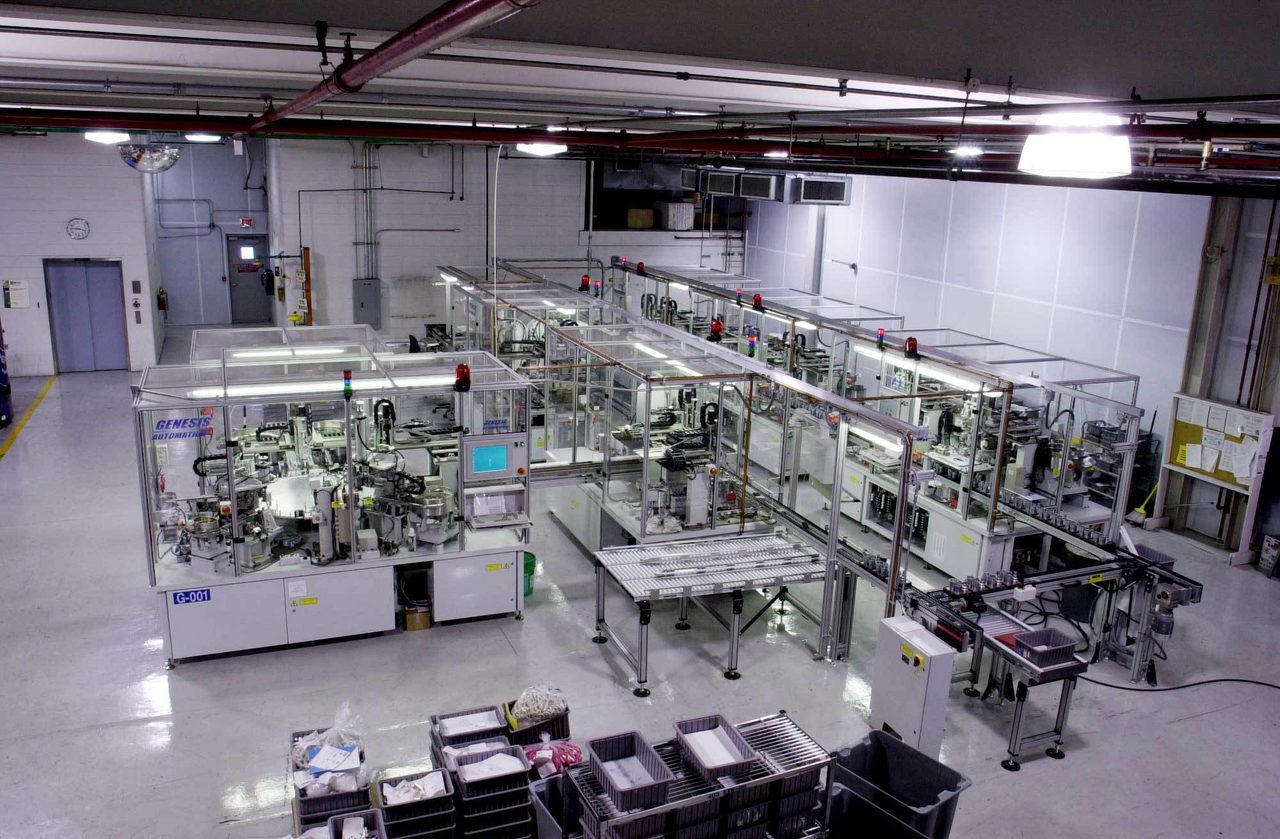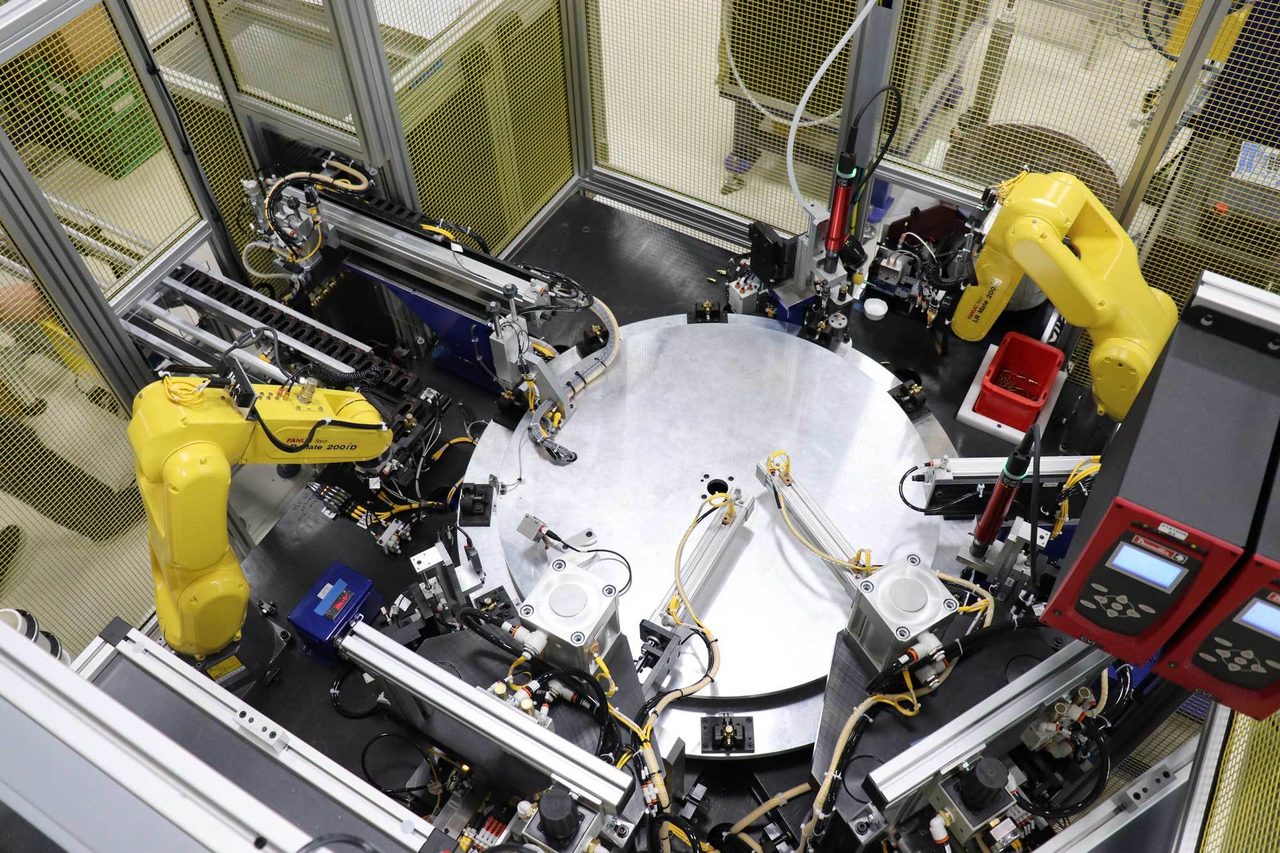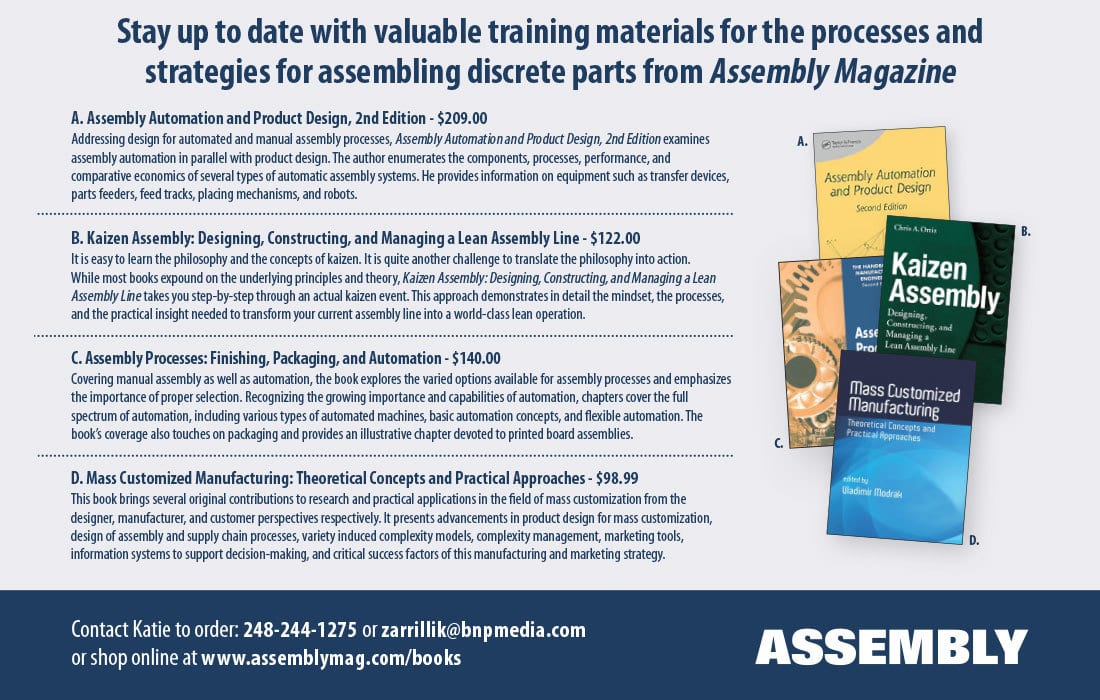Assembly Automation
John Sprovieri // Chief Editor
In the right application, manufacturers can reuse some or all of existing assembly systems for new projects.
Retool, Rebuild or Start Over?
Space is a major consideration when considering whether to retool an existing system. Engineers can’t install 12 workstations on a six-station indexing dial. Photo courtesy Genesis Automation
Product life cycles are getting shorter. For example, 20 percent of consumers replace their televisions every four to five years; another 5 percent replace their sets every one to three years. Smartphones are even worse. On average, consumers replace their phones about every 2.5 years.
In that light, it may seem counterintuitive to expect a multistation automated assembly system to last for a decade or more, but there are examples out there. In 1990, Lanco Assembly Systems built a machine to assemble compacts for a cosmetics company. That machine is still running today. And why not? While cosmetics colors might change with fashion trends, the basic form factor of the compact itself has not. Thus, with proper maintenance and little or no changes in tooling, the machine has been able to churn out product for years.
“That customer has made an absolute fortune off of our machine,” boasts Tim Neale, global account manager at Lanco Assembly Systems.
Rick Blake, president of Edgewater Automation, has seen both sides of the equipment longevity equation during more than 30 years in the custom automation business. In the mid-1990s, his company built a machine to make small backup batteries for exit signs and other devices. The form factor of the battery hasn’t changed since then, and the machine is still running today, albeit with a few minor modifications.
On the other hand, Blake has also worked on machines to assemble computer peripherals, such as external hard drives, for some of the largest OEMs in the world.
“Longevity really depends on the market you’re serving. For electronics customers, it’s all about getting to market,” says Blake. “We’d put those machines together; they’d run three to five years; and then we’d tear them down and reconfigure them for another three years of production. After that, the OEMs would redeploy them. Product life cycles are so short in that industry.”
Creating a durable, reliable machine doesn’t happen by accident. It takes good design, careful planning and ample communication between the integrator and the customer.
“We always try to use top-of-the-line components in our machines,” says Neale. “They are better engineered, well made and have a longer lifespan. You don’t want to replace components after a year and a half. Certainly, there are a lot of machine builders that will compromise on components to save money. A high-quality component might be more expensive, but it will save money in the long-term.”
Most assembly systems don’t run for decades. A lifespan of five to 10 years is more typical, depending on the product and the industry. In the automotive industry, for example, a machine to assemble a stable component, such as a solenoid switch, might run for 10 years or more. On the other hand, a machine to make an aesthetic component, such as an interior subassembly, might only run for five years until that component is redesigned for the next model makeover.
Machine lifespans are typically longer in the medical device industry. A machine to assemble a simple device, such as a syringe, could conceivably run for 20 years or more.
That’s not to say, however, that the machine will run that long. Even the best-designed, best-maintained assembly machine can’t stop the march of time.
“Just like a car, an assembly machine is going to become less and less efficient over time,” Neale points out. “And, as technology advances, the next issue our customers might run into is the availability of replacement components.”
Planning for the Long Run

Manufacturing technician Christopher Lord adjusts a mechanism inside an automated assembly system. Photo courtesy Lanco Assembly Systems
While most manufacturers have an expectation of how long a particular product might last on the market, that forecast is rarely written into the specifications for an automated assembly line.
“It’s always best to disclose all expectations of the automated equipment’s performance,” advises Adam Gustafson, applications engineer at Genesis Automation Inc. “The expectation for the useful life of the system can be just as important as the cycle time.”
Similarly, the expected longevity of a machine—or the possibility of reusing any or all of its components—is rarely factored into a manufacturer’s calculations for return on investment (ROI). Rather, variables such as decreased labor, increased capacity, improved quality and lower piece-part costs are part of the equation.
“Reuse of equipment for other future products is often a goal, but the reality is it’s too difficult to know exactly when one product will stop being made and when the next will begin—if it begins,” says Gustafson. “As a result, reuse of equipment for future products is not used by manufacturers in their ROI calculations.”
Blake agrees. “We’re building a machine right now that I know will be running for 10 to 15 years, even if the product changes over that time,” he says. “But, I don’t think the customer expects to wait that long to see a return on investment. For most companies, the ROI period is three to five years.”
That’s not to say, however, that manufacturers do not consider long-term plans or goals when specifying an automated assembly system. With enough warning, systems integrators can design a machine that can assemble Product A today, but also assemble Product B and Product C in the future.
“If the customer can define a range of requirements that future products will be within, then the automated system can be designed for future product compatibility,” Gustafson points out. “Depending on how future product designs and requirements will vary, there are many ways to address this.
“When designing with future product designs in mind, engineers can make part nests and contact tooling with change-out features,” he continues. “In a sense, all product-specific designs are modular and easily removed from a neutral mounting surface that can accept something else in its place.
“It’s also important to design part nests, tooling, mechanisms and stations with a little extra space around them. Since future products will likely have a different shape or geometry, you need to leave room to accommodate those features. In some cases, it may even be necessary to leave room to add a new station, or an entire module, to the system if new products have very different requirements.”
“The savviest customers have at least a sense of what their future needs might be, and we try to bring that to the party, too,” adds Blake. “For example, we might point out that if we left a little extra room here or there, it would enable them to assemble product variants in the future. Almost all of our customers want that—if it doesn’t cost them extra. And, sometimes it doesn’t cost them extra. Sometimes, just planning for it is enough.”
On the other hand, designing for reuse can also lead to compromises. “When we’re designing for a single purpose, then our machine design can much more heavily favor speed, efficiency, space savings, and even simplicity and cost,” Gustafson adds. “Designing for reuse often means designing for the unknown, which means you need to leave the design open for other features that aren’t necessary at the current time.”
We’ve Had a Good Run, But…

Asynchronous systems built around pallet-transfer conveyors are easier to retool and reconfigure than synchronous systems built around linear or rotary indexers. Photo courtesy Genesis Automation
All good things must come to an end, or so the proverb goes. When an automated assembly system ends its run, manufacturers have several options. Sometimes, the machine is simply scrapped. In other cases, as with a machine to make an automotive component, it might be sold to another company to produce low-volume aftermarket parts.
In rare instances, the integrator might buy it back. “Getting a machine back is usually of little value for an integrator,” admits Gustafson. “The cost of removing and inventorying equipment to maybe use it again someday is not worth the effort. Reused components would probably be close to obsolete by the time we get them back. Not to mention, they would be without the manufacturer’s warranty.”
In theory, any component that has been well-maintained and has not been overused could be redeployed in a new assembly system. However, before cannibalizing components from an existing system, engineers should consider the remaining life of the equipment, the future availability of replacement parts, and the lack of a manufacturer’s warranty.
Robots are frequently reused, while actuators are reused much less often. “If a cylinder already has 2 million cycles on it, do you really want to reuse it?” asks Blake. “Will it even have the right stroke or the right bore size?”
Retooling and reusing an entire assembly system is a different proposition. In some cases, it could hamper the integrator’s ability to design the most efficient and effective system. But, it can be done.
“We have retooled existing systems to make a similar product or a family of similar products,” says Neale, adding that “similar product” is the operative phrase.
“You can’t assemble a medical device on a system that was originally designed to produce an automotive part,” he notes.

Robots are frequently reused in automated assembly systems. Photo courtesy Edgewater Automation
In addition, says Neale, deciding to retool an existing system or start from scratch is like deciding whether to a buy a used car or a new one. Sure, an older car might cost less, but a new vehicle will have all the latest technology, like air bags and driver assist systems.
In February, Lanco shipped out a retooled assembly system for a medical device manufacturer. That system featured new servo-driven electric actuators and a state-of-the-art laser welding system.
“It was a perfect application for retooling,” says Neale. “The customer saved money, and it got a machine equipped with the latest technology.”
Asynchronous systems built around pallet-transfer conveyors are easier to retool and reconfigure than synchronous systems built around linear or rotary indexers.
“We certainly have retooled dial machines,” says Blake. “The indexers themselves last forever. It’s just the product footprint you need to worry about.”
Cost is a major consideration when considering whether to retool an existing system, of course. If 90 percent of the existing components need to be replaced, there’s little point in reusing the remaining 10 percent.
Another important factor is space. “You want to use the right tool for the job. You can’t do 12 stations of work on a six-station indexing dial,” Blake points out. “If you’re going to retool an existing system, make sure that it’s still supported and that you can get spare parts for it. But if you can reuse it, why wouldn’t you, if it can save you money? Getting new machine components is an issue now, too, so if you have a machine you can reuse, there might be some real value in that.”
Some factors are less tangible. “Sometimes, it’s a matter of customer preference,” says Paul Beduze, sales manager for IMA Automation North America. “They have lived with the machine for many years. They know best if they want to keep it going for a new product.”

Creating a durable, reliable machine doesn’t happen by accident. It takes good design, careful planning and ample communication between the integrator and the customer. Photo courtesy IMA Automation North America
Another issue to consider when retooling an existing system is production capacity and downtime. If an existing machine just needs a maintenance overhaul, that can be done on a weekend or a shift. But a complete retooling job is going to take a while, and the machine will not be assembling product during that time.
When retooling an existing system, integrators will examine every component. Indexers and conveyors might need new bearings. Linear and rotary actuators will have to be replaced. Anything that touches the parts—gripper fingers, fixtures, feeder bowls—will need to be custom-made for the new product. Components such as PLCs, sensors and vision systems will likely need to be updated to the latest technology, particularly if the manufacturer is pursuing Industry 4.0 goals.
Updating the control system is typically the most difficult part of a retooling project. “If you try to run new control system without proper interfaces to the old components, and it can it can be a much more difficult retrofit the system,” Blake points out. “It can be done, but it will take more engineering than if you are able to start with the blank sheet of paper.”
Safety is another concern. “Today’s safety standards are completely different than what they were 10 or 15 years ago,” says Neale. “If we retool an existing system, the safety circuit must be brought up to OSHA’s current standards.”
ASSEMBLY ONLINE
For more information on assembly automation, visit www.assemblymag.com to read these articles:



